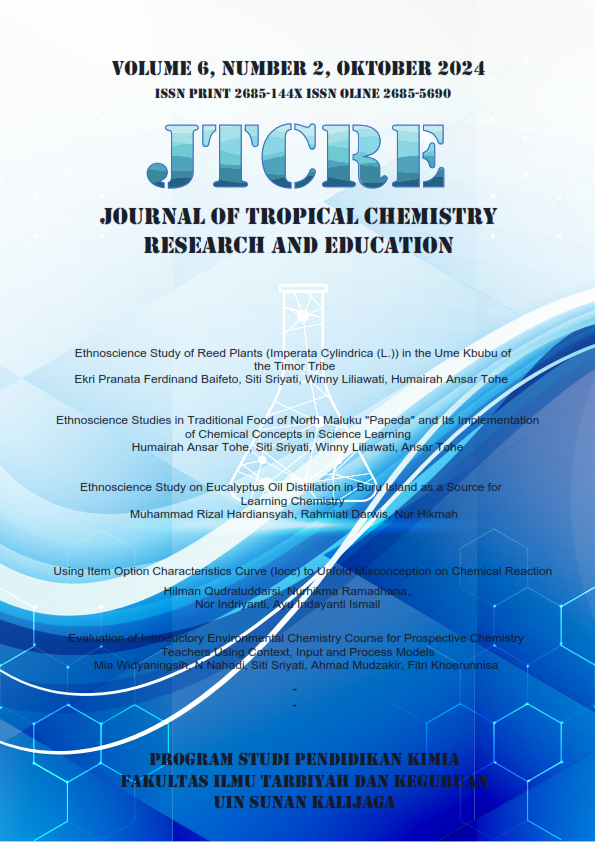Ethnoscience Study of Reed Plants (Imperata Cylindrica (L.)) in the Ume Kbubu of the Timor Tribe
DOI:
https://doi.org/10.14421/jtcre.2024.62-01Keywords:
Reeds, Imperata cilindrica (L.), Ume kbubu, Timorese, Science learningAbstract
The alang-alang plant is believed to be a good thermal insulation, but unfortunately, it is starting to be abandoned. The purpose of this study was to investigate the use of reed plants (Imperata cylindrica (L.)) as a basic material in the manufacture of ume kbubu of the Timorese tribe. This research was conducted in the South Middle Timor District, East Nusa Tenggara Province. The method used in this research is the triangulation method, which analyzes primary data in the form of observation data, interview data, and literature studies. The results showed that alang-alang (Imperata cylindrica (L.)) is used by Timorese people as an ume kbubu roof due to several factors such as its abundant availability, cheap, strong, durable, and cheap. Through scientific studies, it can be explained that alang-alang (Imperata cylindrica (L.)) has a strong structure, contains high lignin and cellulose, is hydrophobic, and has anti-microbial and antioxidant properties that can help protect plants from pests and diseases. In addition, the influence of the shape of the roof construction using alang-alang which has a hollow structure makes the ume kbubu roof a good thermal insulator. The study of community science and scientific science on using reeds (Imperata cylindrica (L.)) as a basic material for making ume kbubu of the Timorese tribe can be integrated into science learning in schools and universities.
Downloads
References
Dalle, R. H. (2017). Karakteristik Sifat Fisis dan Mekanis Papan Partikel Alang-Alang dengan Variasi Ukuran Partikel dan Kadar Perekat Isosianat. Skripsi. Universitas Negeri Jakarta, (https://shorturl.at/ABKNU)
Damaru. (2011). Alang-Alang. Makalah Ekologi Tumbuhan. Universitas Sumatera Utara. Medan. pp. 29
Danong, M. T., Nono, K. M., Bhuja, P., Boro, T. L., Ruma, M. T. L., & Jamida, M. K. (2021). Inventarisasi dan Pemanfaatan Jenis-Jenis Tumbuhan Sebagai Bahan Bangunan Rumah Adat Mbaru Niang Kampung Wae Rebo Desa Satar Lenda Kecamatan Satarmese Barat Kabupaten Manggarai. Jurnal Biotropikal Sains, 18(2), pp. 40– 49
Denzin. (2014). Handbook of Qualitative Method. (www.e-bookspdf.org). Retrieved on February 9th
Derbyshire, H., dan Miller, ER (1981). “Fotodegradasi kayu selama penyinaran matahari. Bagian 1: Pengaruh pada integritas struktural potongan kayu tipis,” Holz Roh-Werkst. 39(8), pp. 341-350.
Dima, Thomas Kurniawan & Antariksa, Antariksa & Nugroho, Agung Murti "Struktur Ume Kbubu di Desa Kaenbaun, Kabupaten Timor Tengah Utara", arsitektur e-Journal 6-1, 12p, 2013
Evans, PD, Schmalzl, KJ, dan Michell, AJ (1993). “Hilangnya lignin pada kayu dengan cepat permukaan selama pelapukan alami,” Dalam: JF Kennedy, GO Phillips, PA Williams (eds.), Cellulosics: Pulp, Fiber and Environmental Aspects, Ellis Horwood, Chichester, Chap. 51, pp.335-340.
Jalaluddin, Dewi, R., & Irda, F. (2014). Pengaruh Waktu Perebusan dan Konsentrasi Pelarut Terhadap Produksi Pulp dari Ilalang. Jurnal Teknologi Kimia Unimal, 3(2), pp. 23-32
Kana, C., Soh, A. Z., Patty-Noach, M. A., Bunga., & Manao, S. P. (1986). Arsitektur tradisional daerah Nusa Tenggara Timur. Departemen Pendidikan dan Kebudayaan, Proyek Inventarisasi dan Dokumentasi Kebudayaan Daerah
Krisnayanti, D. S. & Bunganaen, W. (2018). Koefisien Limpasan Permukaan Untuk Embung Kecil di Nusa Tenggara Timur. Lembaga Penelitian Universitas Nusa Cendana Kupang
Martha, D. A. B., Prihastanti, E., & Hkaryanti, S. (2016). Perbedaan Kadar Glukosa, Karotenoid dan Biomassa Alang-Alang (Imperata cylindrica L. Beauv) yang Tumbuh di Daerah Ternaungi di Kec. Kunduran Blora dan Ungaran Timur Semarang. Buletin Anatomi dan Fisiologi, 1(1)
Peter, R. & Simatupang, M. S. (2022). Keberagaman Bahasa dan Budaya Sebagai Kekayaan Bangsa Indonesia. Dialektika: Jurnal Bahasa, Sastra, dan Budaya, 9(1), pp. 96–105
Pratiwi, N., Hamzah, B., & Mulyadi, M. (2017). Alang-Alang Sebagai Material Insulasi Termal. Prosiding Seminar Nasional Energy Efficient for Sustainable Living, 3(12)
Sembodo Dad R. J. (2010). Gulma Dan Pengelolaannya. Yogyakarta: Graha Ilmu
Steffen, K.T. 2003. Degradation of Recalcitrant Biopolymers and Polycyclic Aromatic Hydrocarbons by Litter-decomposing Basidiomycetous Fungi. Disertasi. Helsinki. Division of Microbiology Departement of Applied Chemistry and Microbiology Vikki Biocenter. University of Helsiniki.
Sujalu, A. P., Ismail, Jumani, Emawati, H., & Milasari, L. A. (2021). Ilmu Alamiah Dasar. Yogyakarta: Zahir Publishing
Sutiya, B., Istikowati W. T., Rahmadi, A., & Sunardi. (2012). Kandungan Kimia Dan Sifat Serat Alang-Alang (Imperata cylindrica) Sebagai Gambaran Bahan Baku Pulp dan Kertas. Bioscientiae, 9(1), pp. 8-11
Suwasdi. (2021). Respon Pertumbuhan, Kandungan Selulosa dan Lignin Tanaman Rami (Boehmeria Nivea L Gaud) Pada Konsentrasi Giberelin dan Dosis Monosodium Glutamat. Skripsi. Universitas Tidar Magelang.
Taiz, L. & E. Zeiger. (2004). Plant Physiology Fifth Edition. Sinauer Associates Inc., Publishers. Massachusetts. 692 h.
Timbulong, A. H., Daniel, C., Chandra, D., Putri, Y. K., & Hariyanto, A. D. (2023). Keragaman Bentuk dan Struktur Ume Kbubu di Pulau Timor. ACESA, 5(1), pp. 56-66
Wardhani, A. K., Uktolseja, J. L. A., & Djohan. (2020). Identifikasi Morfologi dan Pertumbuhan Bakteri pada Cairan Terfermentasi Silase Pakan Ikan. Seminar Nasional Pendidikan Biologi dan Saintek (SNPBS) ke-V 2020
Wikipedia. (2024). Ume Kbubu. Diakses pada tanggal 09 Mei 2024 (https://id.wikipedia.org/wiki/Ume_Kbubu)
Yuwono, S. S. (2015). Tanaman Alang-Alang (Imperata cylindrica). Universitas Brawijaya. Diakses tanggal: 09 Mei 2024 (http://darsatop.lecture.ub.ac.id/2015/10/alang-alang-imperata-cylindrica/)











